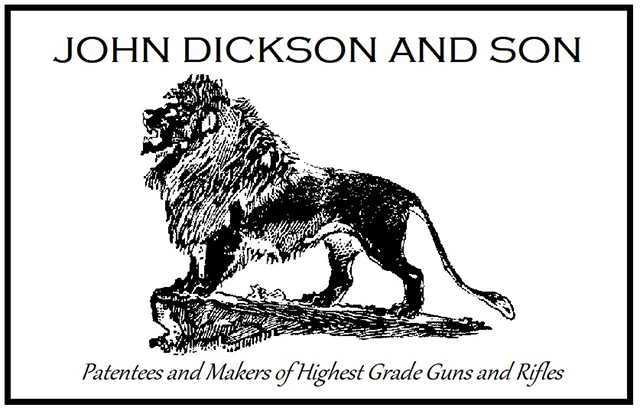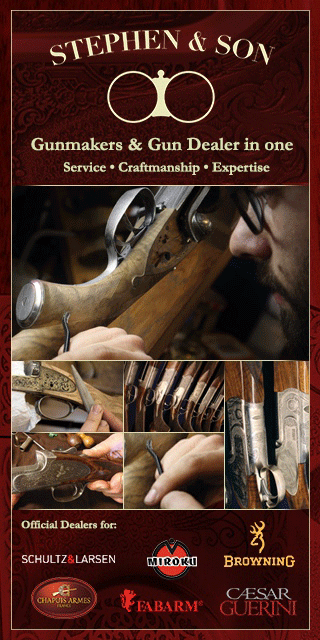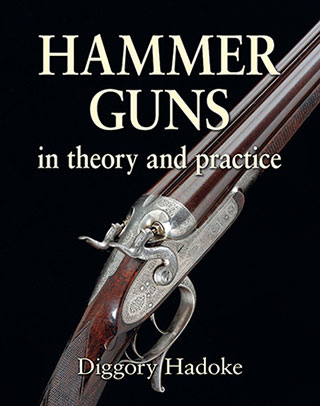Is it science? Is it magic? Is it a formula or a dark art? Everyone seems to have an opinion about the best means of getting a rifle with one barrel attached to another to place two shots side-by-side within an inch or two of one another, at the desired range. Diggory Hadoke gets to grips with the gritty subject of double rifle regulation.
Not many companies still make double rifles. In the UK, I can name a handful: Holland & Holland, Rigby, Purdey, David McKay Brown, Westley Richards. Of continental makers, Chapuis, Heym, Krieghoff spring to mind. The double rifle, once the mainstay of the deer stalker, the big game hunter and the driven boar enthusiast, has largely been surpassed by bolt-action magazine rifles, which are cheaper to make, accurate, reliable and, above all, easier to make shoot tight groups and simple to adjust, as and when necessary; for example, when changing optics or ammunition.
The old double rifles of the Victorian and Edwardian eras were painstakingly tested and adjusted in order to make them deliver accurately, with the desired powder load and bullet weight. Looking into the cases of vintage double rifles, we will often see, on hand-written labels, pasted to the lid, detailed loading instructions, with specific notes on powder, bullets, wads and patches. If the sportsman followed the recipe, he could be confident that the rifle would shoot in the manner intended. The necessary bespoke loading tools were often included in the case.
I met up with one of Britain’s foremost rifle regulators, Keith Dennison Thomas, while he was busy regulating a new .416 Rigby double ‘rising bite’ side-lock at the West London Shooting School. Not to be confused with Keith Thomas, the gun engraver, Keith has over two decades of regulating double rifles under his belt. He explained to me some of the procedures and challenges of making double rifles shoot accurately.
The tools of the trade.
Regulation takes place at the range. There are indoor ranges, like to one at Westley Richards, which is fully enclosed underground. There are also open air ranges, like the one at the West London Shooting School.
Arriving at the range, the regulator will have with him a collection of essential kit to be employed during the process. The most obvious being ammunition. This needs to be from a single batch, to minimise variation. The average rifle requires sixty rounds of ammunition to regulate.
The regulating jig is a contraption that fits over the barrels and has hex head bolts in multiple positions for adjustment. A gas bottle is required to provide the heat, binding wire and aluminium wedges are for support. Measuring tools, pliers, rosin flux, tin wire, a lighter, cleaning brush and a tin to store the front sight when not in place complete teh essentials.
If a proper bench and vice is available, as at Westley Richards, that is ideal. If not, a Black & Decker ‘Workmate’ will do the job. British weather being what it is, if working outdoors, a shelter of some kind is helpful.
The job is made easier if two people are involved. If one shoots and one spots (good optics make this faster), it saves time. Also, the strain of repeatedly firing a heavy rifle is better spread between two over the day. Recoil fatigue can affect the shooter and the results.
For a target, the initial four sighter shots are fired at a black dot. This initial shot sequence provided a datum point for the rest of the work. Thereafter, the A3 size half-moon target is used, with a one inch grid pattern to make adjustments easier to calculate from up range. For example, a British .470 will approximate a thou’ of adjustment at the muzzle with an inch of movement on the target at 65 yards.
Regulating new rifles.
Once set up at the range, those first shots will determine the next move. Most new rifles will arrive with a consistent point of impact, usually within six to eight inches of each other. Keeping the sight in the centre, one barrel is moved at a time. To adjust the right barrel, the left is clamped and the barrels heated with the torch to melt the tin. The barrels will expand five to seven thou’ when hot. The wedge is moved and pressure applied to the right barrel in the jig. It moves, is allowed to cool, then test fired again. The process is repeated until the regulator is happy with the result.
Acceptable results equate to an inch and a half at 65 yards. Some people prefer a longer distance these days, especially boar hunters, who often want the rifle regulated to one hundred yards. The regulation distance is important. For example, a rifle regulated to touch bullets at fifty yards will be crossing at seventy; meaning the right barrel’s bullet will impact to the left of the left barrel’s bullet. Barrels regulated, as Keith prefers, to shoot within and inch and a half of each other at sixty five yards, won’t start to cross until they reach a hundred yards.
A number of factors affect the results of each part of the regulating process. Light, thin rifle barrels on many foreign double rifles react more erratically to each adjustment than the, traditionally thick, barrels on British rifles. Small calibres are very sensitive and often the act of heating alone will cause the point of impact to change significantly. This is where the regulator must draw on his years of experience to ‘feel’ each adjustment as he eases the barrels to the optimal positions for performance. In general, big, slow bullets are easier to regulate than small fast ones.
Regulating old rifles
Many a hunter has eyed the tempting array of fine double rifles in the auction racks and mused about taking one to Africa. It is something of a lottery to get involved in this game. I was with a client at Holt’s a few years ago and we picked up a lovely George Gibbs boxlock double rifle in .22 Savage Hi-power. Fortunately, the targets supplied with the rifle to show its performance were accurate and I later hunted wild turkey in Texas with it.
However, the same client had a .375 flanged by Cogswell & Harrison, which a US based regulator failed to get to shoot acceptable groups before a trip to hunt dangerous game in Africa. That rifle eventually found its way to Westley Richards for regulating. It now shoots very well and I killed a huge crocodile with it in Tanzania a few years later.
Ammunition
Whatever its origins, when a rifle was made, it would have been carefully regulated with the desired ammunition, with a particular weight and grain of black powder or one of the emerging ‘smokeless powders’ of the early twentieth century, such as Cordite. To replicate the performance characteristics of these powders today requires some experimentation.
Kynamco have, for some years produced ‘obsolete’ calibre ammunition for sportsmen but a lot of people load their own ammunition, with the help of technically useful books, like ‘Shooting the British Double Rifle’ by Graeme Wright, and careful experimentation at the range. This way, some of the once dormant rifles of the past, like the beautiful black powder express hammer rifles of the 1870s and 1880s in .450 and .500 calibre have been brought back into service. Also, some of the big double nitro express rifles for dangerous game. like the .450 N.E, which fell out of favour before the First World War are now being carried in the bush and put to good use.
A key issue for double rifle performance is consistency of ammunition. Federal .470 cartridges have not changed since the 1990s and will perform exactly the same today as they did 30 years ago. Kynamco have periodically changed their brass supplier, primers and powder, totally changing the characteristics of each round. One newly regulated .375 was shooting 1 1/2” groups and when a new box of ammunition was introduced, the groups moved to 6 1/2”. That is no use for hunting! It is best to buy a large quantity of same batch ammo when you set up the rifle: enough to last your lifetime of shooting (fortunately big doubles do not normally get fired hundreds of times a year).
A word of warning; monolithic solid bullets have become the desired projectile in some quarters but Keith will have nothing to do with them. The old steel barrels do not handle them well and will be irreparably damaged by their use. ‘I won’t use any monolithic or hydrostatic bullets”, he told me, “They have destroyed a lot of good rifles”. Tell tale signs include the appearance of a shadow of the rifling on the outside of the tubes, or ripple effects in the steel.
Learning to be a regulator
Regulating rifles is not an easy job for the hobbyist to have a go at. Many have been delivered to professionals, like Keith, here, after American or Australian enthusiasts have ‘had a go’. The usual problem is that by heating the barrels, they lose all the solder that holds them solid and the rifle then ‘shoots all over the shop’, according to Keith. In such cases, the barrels need to be fully stripped and ribs re-laid. The accumulated debris under the ribs needs properly cleaning out first.
Keith learned how to regulate by helping Paul Willis and David Perkins when they were doing the job for Rigby and Paul Roberts, back in 1994. At first, Keith was there to shoot the rifles but the two masters soon involved him in the regulating and taught him the skills to undertake the whole job for himself. Keith then spent a decade working for Purdey and a period in self-employment, building guns and rifles as well as regulating rifles for several gunmakers, before taking a foreman’s position at Westley Richards in 2007. Five years ago he returned to a free-lance role and continues to work for a number of gun and rifle makers.
We are fortunate to still have a small number of really skilled and experienced professionals, like Keith Dennison Thomas, who understand, and can perform, these essential services for the bespoke gun building trade. Without them, many of our old and new rifles would never perform to their potential and deliver the service that we hunters need. I just hope he passes his skills on to the next generation.
Published by Vintage Guns Ltd on



